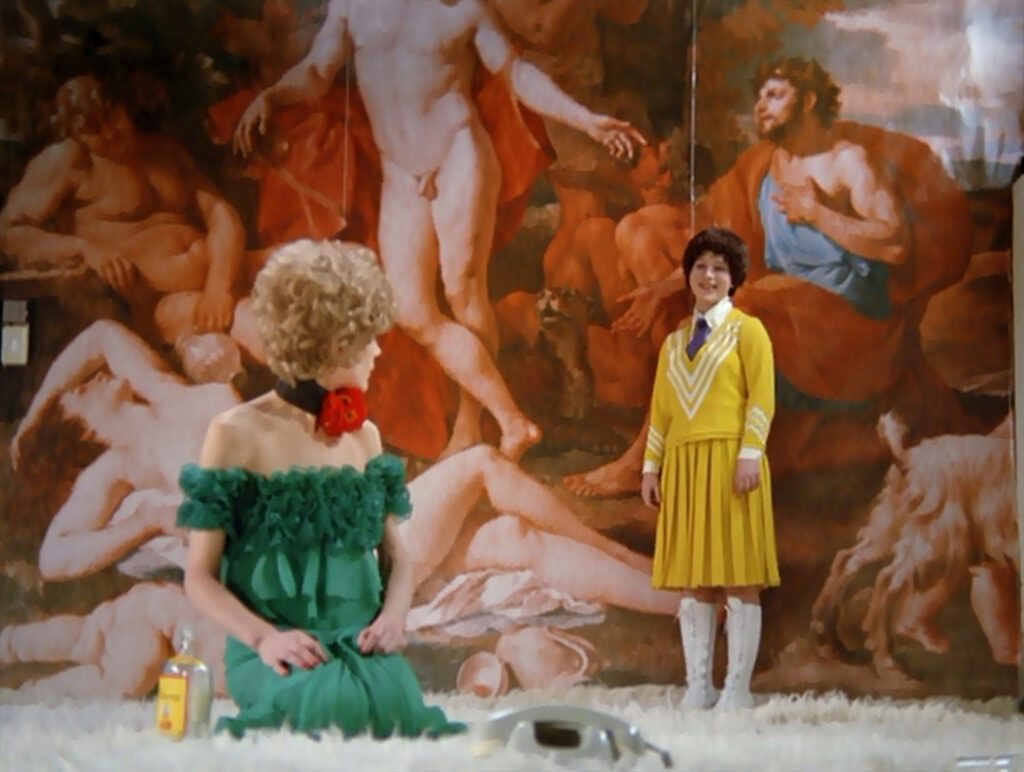
The Bitter Tears of Petra von Kant
1972, directed by Rainer Werner Fassbinder
The Bitter Tears of Petra von Kant begins cryptically with an inscription dedicating the film “to the one who became Marlene here.” It appears to be a private reference, as if Fassbinder had modeled Irm Hermann’s character, the slavish Marlene, after someone he knew – but there’s evidence for a more accessible meaning. In any case the dedication implies that Marlene is much more than a background character, even if she never utters a single line. She’s the first character seen, and her name is the first word spoken. She is present at the beginnings and ends of all five acts, except at the start of the fourth when it’s important that Petra be alone. Marlene sets the drama in motion, raising the blinds to wake Petra and fill the house with light on the first day, and she turns the lights off when she walks away at the end, leaving Petra alone in bed.
Consistent with the movie’s understated humor, there’s a strong hint that Marlene is the real fashion designer, and that Petra takes credit for her work. We never see Petra working, but Marlene is usually busy at the easel or arranging clothes on a mannequin. Petra praises Marlene’s changes to some sleeves, and she tells Karin that Marlene “does all my work for me.” Petra is such a liar that it sounds like a credible slip – that Marlene literally does all the work. Marlene has been with Petra for three years, and three years ago Karstadt wouldn’t even look at Petra’s designs.
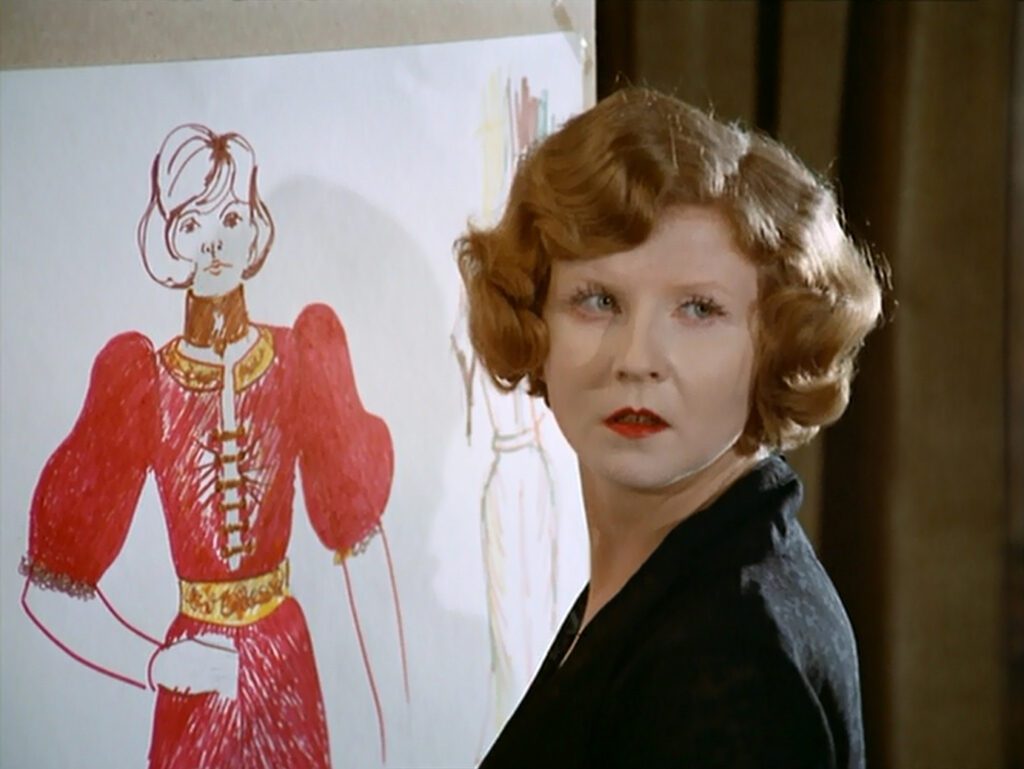
Virtually everything you could say about Marlene can also be said of the film’s audience. Petra tells Sidonie that Marlene “hears everything, sees everything, knows everything.” She is silent for the duration of the film, as most people are while watching a movie. She is obedient, like anyone who follows a movie’s twists and turns without complaint. It’s easy to forget she’s there, just as viewers forget themselves while engrossed in a movie. Her masochism is like that of moviegoers who eagerly submit to a movie’s horror, violence, suspense, or emotional anguish. She is in love with Petra, like a movie fan who adores a screen idol. If Marlene is truly the creative force behind Petra’s fashion designs, then she reflects the creativity of a good audience who must use imagination to transform the inert material of film into a living reality. Marlene is also the only character who crosses the plane of the large windows in front of Petra’s bed – a plane that functions as a symbolic “fourth wall” separating audience from characters. Twice she stands at a perpendicular window looking into the bedroom/studio where all the drama is set.
Fassbinder’s dedication, in that case, is to his viewers, who “became Marlene” in this film. In other words, The Bitter Tears of Petra von Kant is a love letter from the director to his own audience. The word “here” is also important; it would be redundant if the dedication referred to some unknown third party, but if it’s the audience, then not only Marlene but also the becoming is right “here” wherever the film is being shown.
This expression of love in the dedication, and in the character of Marlene, is all the more intense against a backdrop so devoid of selfless love. For two hours the speaking characters constantly reach for one or another idea of love – friendship, family, sex – but it always falls short, thwarted by selfish desire. Underneath Petra’s long conversation with Sidonie is a kind of one-upmanship as Petra, calmly but with visible tension, deflects Sidonie’s pity. When Petra and Karin get to know each other, Petra keeps probing for common ground and coming up disappointed. The third act is again full of negotiation as Karin asserts her independence, and the fourth act is a long display of raw unrequited desire.
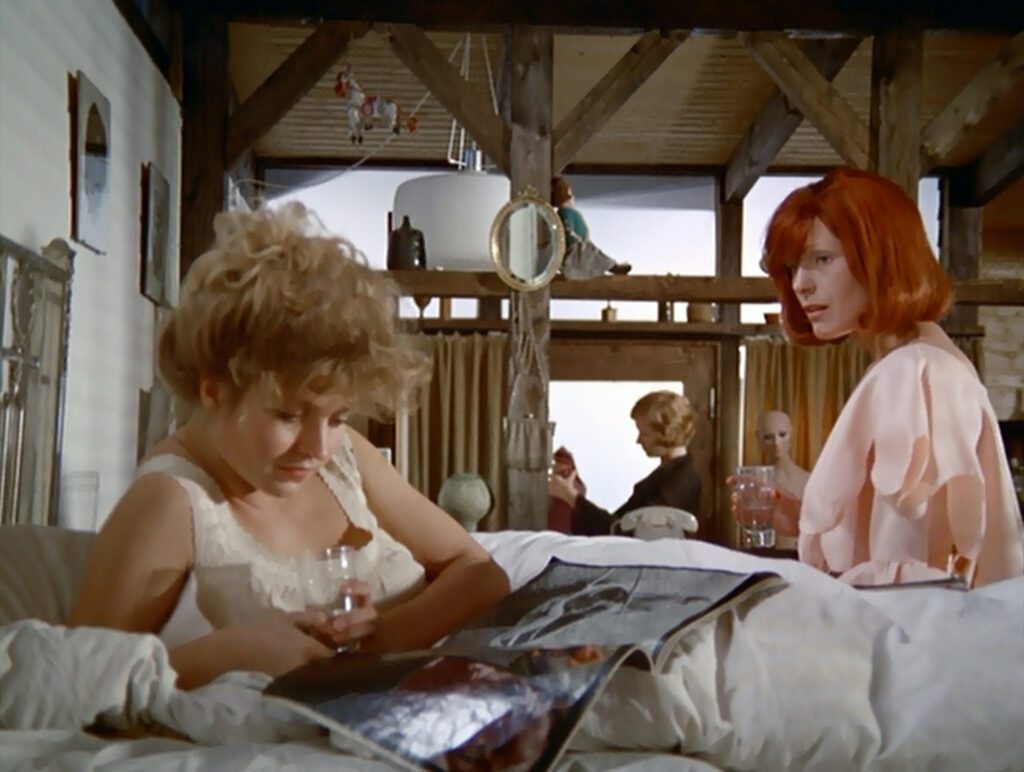
At the end of the drama when all the guests have left, Petra apologizes to Marlene and promises her the freedom and fun she’s been missing. Marlene reaches to kiss Petra’s hand, but Petra doesn’t want to be the master anymore. When she asks her servant to “tell me about yourself” Marlene’s aspect changes. She turns away from Petra, opens a suitcase, and begins packing to leave. In the same way, most people watching a movie are happy to stay as long as they can watch passively, but as soon as the movie demands engagement or asks them to examine their own lives, they turn their backs. Marlene packs the same things audiences normally want from a movie: action (a pistol), music (a record), nice words (a book), and memories of beautiful people and costumes (a doll and some clothes), leaving behind what counts most – in this case Petra herself.
The ending may reveal the limits of Marlene’s love for Petra, but that doesn’t diminish the love declared in the dedication – the love directed at the audience via Marlene. The Bitter Tears of Petra von Kant has no romantic notions of love; on the contrary, it aims to see and accept people for what they are. Everyone wants love, but their capacity for love is limited, and their weaknesses invariably result in disparities of power that stand in the way of love. All the characters fall into hierarchies, either by default or through jockeying. Even the two cats in the opening shot are on unequal levels of a staircase. Petra and Sidonie both come from aristocratic families, but Karin is an outcast among commoners, although her youth, beauty, and personality are enough to reverse the inequality between her and Petra.
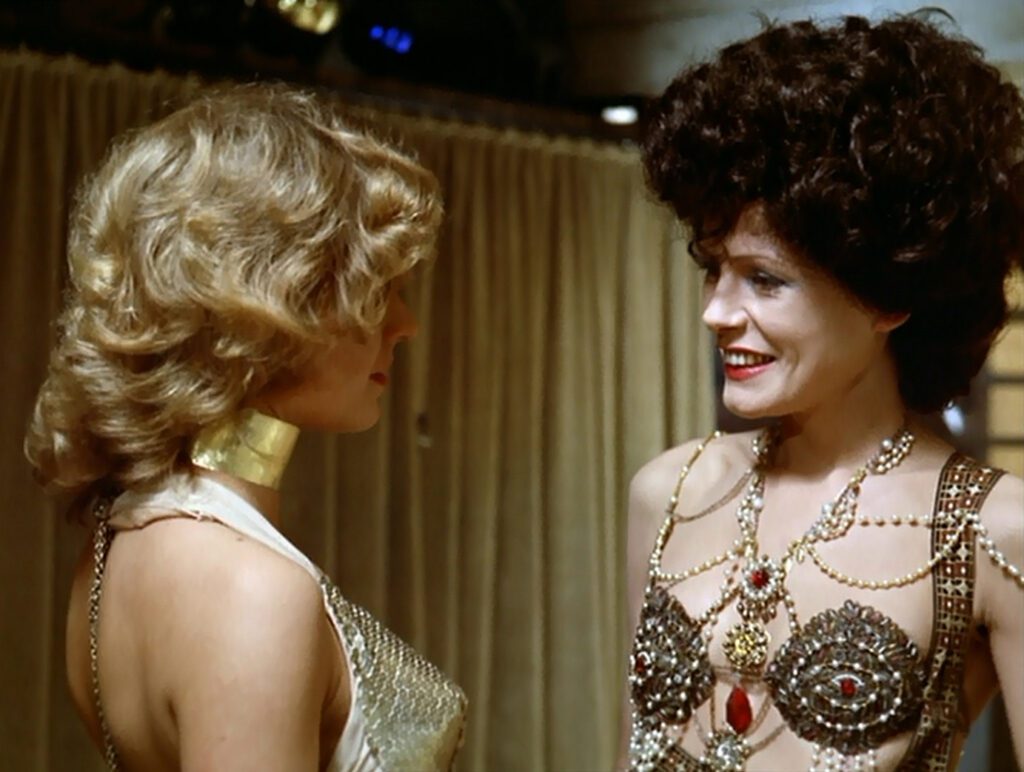
With all of its antagonism and emotional crises, the movie’s point of view might be mistaken for cynicism, but there’s no lack of sympathy for any character. In fact The Bitter Tears of Petra von Kant should leave us with a faith in the possibility of love despite everything in human nature that conspires against it. Petra’s long suffering – which gives the film its title – balances her many faults, yet instead of coming across as punishment, her “bitter tears” humanize her. By the end, when Marlene leaves, Petra looks at her servant with a calm smile. In spite of her cruelty and selfishness, she is ultimately sympathetic.
The opening scene credits an important source of inspiration. Before any guests arrive, Petra has Marlene type a letter to Joseph Mankiewicz, acknowledging a debt but saying she won’t pay it. The famous Hollywood screenwriter and director was still alive in 1972 and about to finish his last film. In Mankiewicz’s most famous movie, All About Eve, Bette Davis’s character Margo Channing suffers the betrayal of an ingenue she had taken under her wing, much as Karin betrays Petra. Both Margo and Petra are ferocious women, divas in their profession, but they’re also both strangely sympathetic. Petra, it seems, lacks the great talent that makes Margo so estimable – she’s as much a fraud as the younger woman who uses her – but that makes her loving portrayal in Fassbinder’s hands all the more impressive.
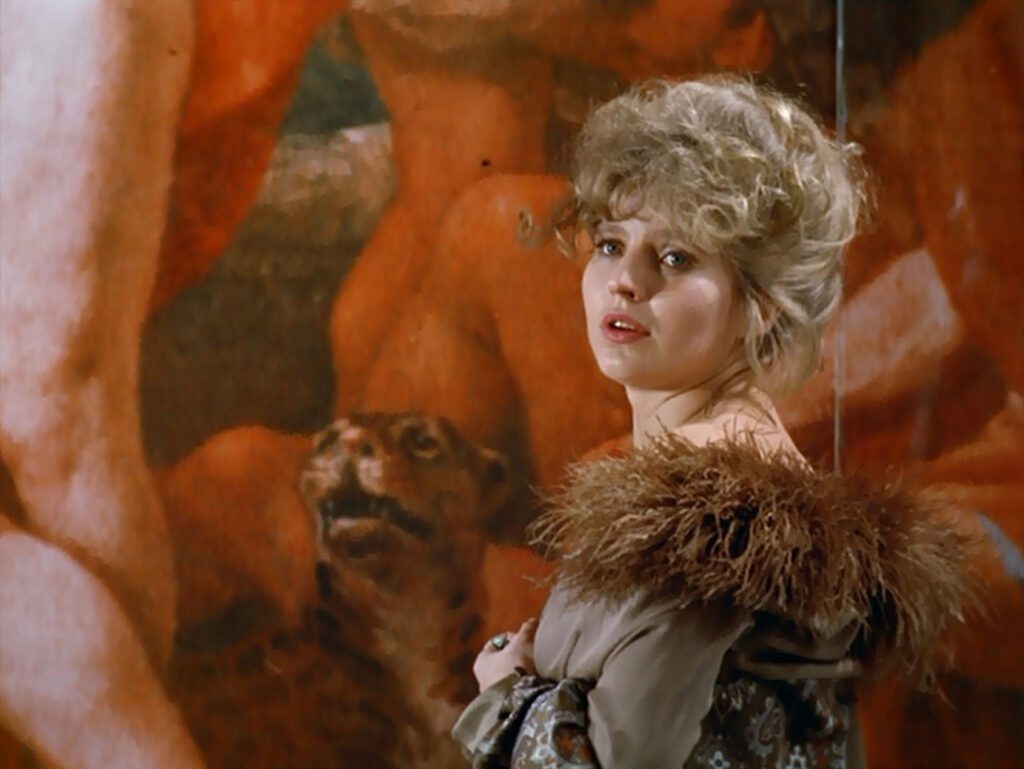
All About Eve ends with a folding mirror, reduplicating the covetous expression on the face of a new aspiring actress named Phoebe. The Bitter Tears of Petra von Kant uses mirrors occasionally – they’re a hallmark of Fassbinder – but in a sense the whole film is like a hall of mirrors filled with reflections, symmetries, and projections. Flanking the action is a wall-sized mural of Nicolas Poussin’s Midas and Bacchus on one side and a collection of dolls and mannequins on the other, both sides echoing the drama in suggestive ways. Karin often stands beside Bacchus’s panther, highlighting her predatory nature, and when Petra’s mother first hears of her daughter’s lesbian relationship she turns to see two female mannequins in a copulating position, driving home the shock she’s just received. In a similar way Sidonie’s birthday gift to Petra, a curly-haired blonde doll, echoes the memory of Karin that obsesses Petra so intensely.
All the various loves, betrayals, and break-ups among secondary characters or in Petra’s past, both seen and reported, mirror the central relationship between Petra and Karin. Marlene’s unrequited love for Petra echoes Petra’s for Karin. Petra has recently divorced her husband, and Karin thinks of divorcing hers. Petra’s mother has found flowers on her husband’s grave, implying that he had cheated on her, and Petra’s daughter Gaby is in love with a boy who ignores her. Petra’s, Sidonie’s, and Karin’s unseen husbands, Frank, Lester, and Freddy, all have English-sounding names. Even the telephone and doorbell reflect each other, each interrupting the action with unwelcome intrusions or false hope. All these duplications have the effect of a kaleidoscope, magnifying the story of Petra’s heartbreak but also stressing how ordinary it is. At the beginning Petra has just awakened from a nightmare, so everything that follows is like a materialization of some imagined experience.
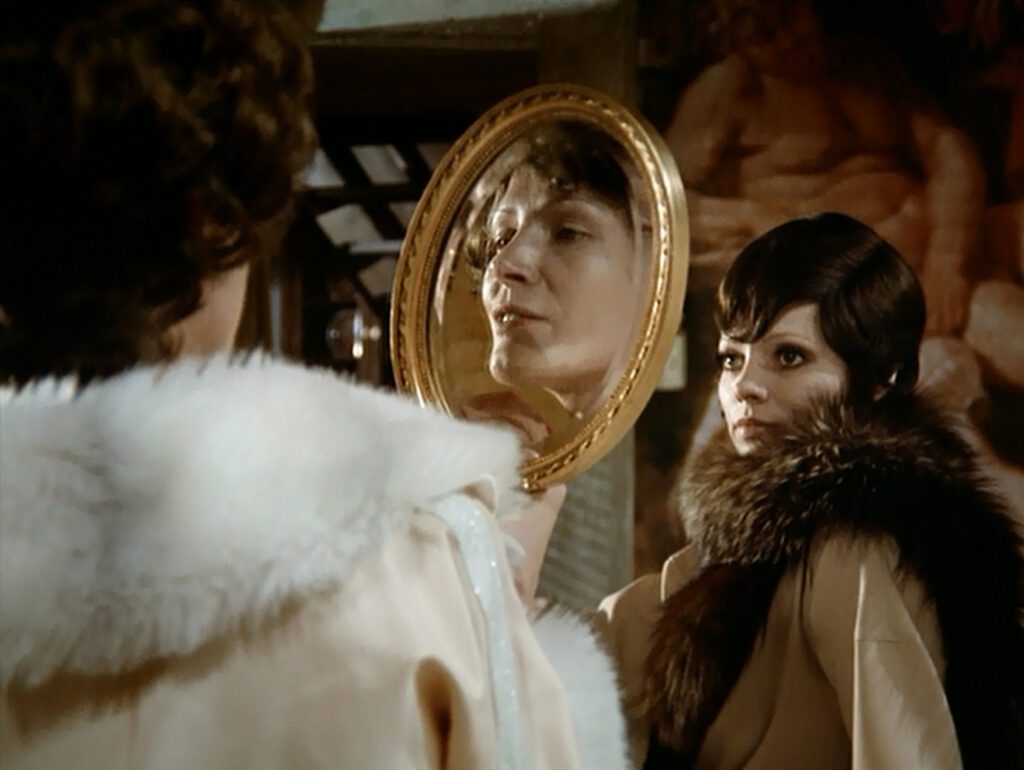
Still, the hall of mirrors is not exactly a chamber of horrors. Near the end when Karin finally calls, Petra has made peace with her heartbreak, and there’s a hint of a promise that both women will carry something positive from the experience. All the movie’s symmetries, and the sense of resolution at the end, create a sense of order behind the emotional chaos of life – an order that can serve as a foundation for a realistic kind of love, without conditions or expectations.
CONNECTIONS:
Les parents terribles – Intimate drama reflecting an underlying order in life
All About Eve – Protagonist’s career usurped by a younger woman taken under her wing
Women on the Verge of a Nervous Breakdown – Agony of waiting for a phone call